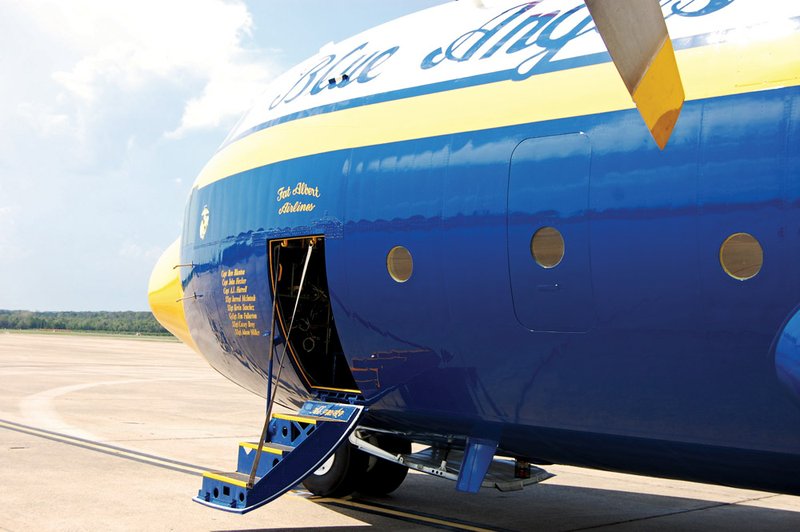JACKSONVILLE — Walking around the body of a C-130 can be pretty humbling.
The large body, so close to the ground, has a high-wing design and is perched upon big round tires.
Being a passenger on a C-130 is a different story.
On a nearly 20-minute flight, Capt. A.J. Harrell gave his handful of passengers, which included five members of the media, the experience of positive and negative G-force as well as zero gravity aboard Fat Albert, a Lockheed C-130 Hercules turbo prop that is part of the Navy’s Blue Angels flight demonstration team. Harrell and his flight crew ran the plane through its practice routine Friday for the 2012 Heritage and Heroes Open House and Air Show that took place Saturday and Sunday at Little Rock Air Force Base.
Blue seats lined the walls of the plane, and the cargo rollers ran up the floor from the back of the plane to the front.
Being a passenger on a plane the size of a Boeing 737 seems like it might include a smooth ride, but climbing aboard Fat Albert led me to a ride of a lifetime, unlike any roller coaster ride I’ve ever experienced. Although it may not be anything compared to the 7.8 G-force the Blue Angels’ pilots feel in the F/A-18 Hornets in which they perform, the 2.5 G’s the passengers felt in the C-130 were enough for the woman sitting next to me to pull out her sick bag.
“The mission of the Fat Albert is to show off the maximum performance of the aircraft,” said Eric J. Rowley, a U.S. Navy public affairs officer.
The Blue Angels, based in Pensacola, Fla., are a Navy flight demonstration squadron that was formed in 1946. The Blue Angels crew is the top of the naval line.
“We have to get down and back up as fast as we can to avoid enemy contact,” said Gunnery Sgt. Jim Fullarton, a flight mechanic for the Fat Albert. “You have to have at least 1,500 hours [on that type of aircraft] to apply [for the Blue Angels]. It’s a more experienced group.”
The name Fat Albert was given to the C-130 in the 1970s when the television cartoon by that same name was popular.
“The kids like it,” Staff Sgt. Casey Brey said about the name. “Can’t call us Delta, so we’re Fat Albert Airlines.”
Harrell told the passengers before the flight that he would give the C-130 maximum power while holding the brakes; then before takeoff, he would release the brakes to give the 120,000 pounds of airplane enough power to take off with a 45-degree tactical climb. That gave us the feeling of 2.5 G’s, twice the force of gravity. We felt negative 2 G’s as the plane leveled out. The C-130 banked hard at 60 degrees and turned sharply.
A typical airliner climbs only 10 degrees or less, and it banks about 15 degrees.
“We trade all that air speed for altitude,” Harrell said. “By the time guys [on the ground] see us, we are flying out.”
Little Rock Air Force Base is a C-130 base, and the pilots of the Fat Albert not only received their training at the base, but the plane goes there for repairs.
After going on the practice flight with the crew on the C-130, the passengers stood on the flight line to the Blue Angels’ practice performance directly overhead.
Now, a flight in one of those F/A-18 Hornets would be the only thing that could top the thrill of a ride on Fat Albert.
Staff writer Jeanni Brosius can be reached at (501) 244-4307 or jbrosius@arkansasonline.com.
